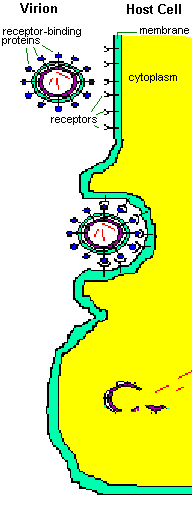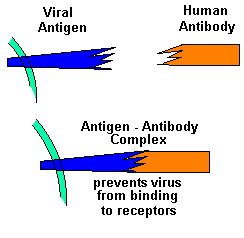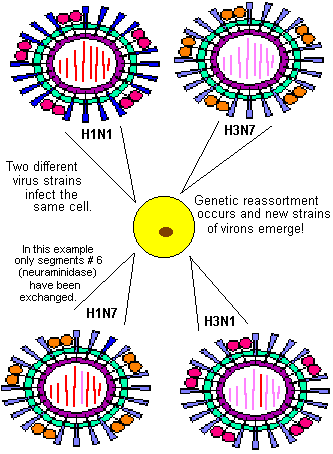"Flu" - recombinant genes on the loose!
Dr Jamie Love 1998-2009 ©
1998-2009 ©
 1998-2009 ©
1998-2009 ©
This page provides an introduction to flu virus and it is best to read it before reading my other webpage about Chicken Flue and Swine Flu, where you will find information about the epidemic(s).
The media have discovered what many scientists have known all
along - viruses are amazing and scary. Unfortunately, the media are more concerned with scaring you than educating you, so you're
wise to have found this page. (Here we'll do both!  )
)
Mankind has always been under the threat of a new, more dangerous
virus emerging and causing massive epidemics. Our modern transportation
systems make it all the easier for such a virus to spread quickly
throughout the world. Man's constant exploration and encroachment
in previously inaccessible parts of the world make it more likely
that something nasty might emerge. However, it is worth noting
that viruses have always been with us, evolving ways to reproduce
and spread. Viruses, like humans, are just playing the evolution
game.
But VIRUSES CHEAT!
What exactly is a virus?

| A virus is a bit of genetic material packaged in a protective coat. The genetic material may be DNA or RNA depending on the type of virus. The protective coat is called a capsid. Not only does it protect the delicate nucleic acid inside, but the capsid also helps the virus infect host cells. Some viruses have an additional outer envelope of proteins, sugars and lipids stolen from the host cell in which it has been made. The complete virus "particle" - nucleic acid, capsid and envelope (if it has one) - is called a virion. |
Virus classification is based upon characteristics of the three
parts of the virion. It is a complex system that requires detailed
knowledge about nucleic acid types and structures, virion shapes,
binding of specific antibodies (this has to do with immunity), and
may even include the nucleic acid sequence itself!
The group names of
viruses are not easy to follow because they're often in Latin
and named after a type of disease which only
one member of that group causes. For example, the family of Herpesviruses
includes not only the virus that causes herpes (herpes simplex),
but also the virus that causes chicken pox and shingles (varicella-zoster),
and another virus that causes mononucleosis and some cancers (Epstein-Barr
virus). Another example of this confusion is that the viruses
which cause hemorrhagic fever (a very deadly disease) are found
in three different families (Arenaviruses, Filoviruses
and Arboviruses). It's no wonder that student doctors have
so much difficulty learning them all. Don't worry about the details
but be aware that viruses with similar names, or that cause similar
diseases, may or may not be similar viruses.
Where do viruses come from? Where do they get their genes?
The origin of viruses is poorly understood, but most virologists (people who study viruses) agree that each virus got started by copying a few useful genes from their host cells. Viruses are ignorant of any patent or copyright laws, they just make a copy of what they find useful in the host's genome and move on. Often that useful gene is intimately involved in the host's reproduction, food gathering, cell communication or other essential function of the cell. Over the generations viruses mutate their stolen genes and when a particularly useful mutation comes along, the virus will use it to further its own survival, usually to the detriment of its host. As the years and generations go by, these viruses can even switch over to other species, find new genes to copy and then continue evolving in their own selfish way. Therefore, viruses were using recombinant genetics long before man had thought of it.
How do viruses reproduce?
|
All viruses reproduce by taking over the reproductive mechanism
of a host cell, so the first thing a virus must do is get into
a cell by passing through the cell's membrane. They do this by
means of their receptor-binding protein. These proteins
are encoded in the viruses' genetic material and they stick out
from the surface of the virion. They are attached either to the
capsid or part of the envelope, depending on the type of virus.
These proteins cause the virion to bind to specific receptors
on the host cell in a manner similar to the way a key fits into
a lock. This interaction between the host cell's receptor and
the virus' receptor-binding protein is crucial and causes the
"specificity of infection". This specificity usually
limits a viruses' infection to specific types of cells and specific
animals (or plants or bacteria) depending on the virus.
For example, HIV (the virus that causes AIDS) has receptor-binding proteins that attach to specific types of human white blood cells. Because of its specific receptor-binding protein, HIV cannot infect skin cells or lung cells so it is not infectious by touch or by breathing it in. In addition, HIV does not infect monkeys because the receptors on monkey cells are not the right shape to accept HIV's receptor-binding protein. However, a related virus, called SIV, can infect monkey cells because it has evolved a receptor-binding protein that attaches to monkey white blood cell receptors. The interaction between a viruses' receptor-binding protein and the host cell's receptor(s) is an on going battle in molecular evolution. The specificity may change as the virus evolves a new gene for its receptor-binding proteins or the host cell evolves new genes for its receptors. This evolution can produce viruses that unexpectedly switch to a new host; either a new type of tissue or a new type of animal. Once the virion attaches to its host cell it is internalized (taken inside) in a matter of minutes. Host cells internalize viruses because the host cell "thinks" the virus is something it "wants", such as food, a hormone, etc.
|

|
The viruses' subterfuge is aided by its receptor-binding protein, which its ancestor probably stole from the host's ancestor long ago. Once inside the host cell, the virion sheds its protective capsid and takes over the cell's reproductive machinery. Some types of viruses will actually slide their genetic material in between the genetic material of the host. Others float around inside the cell's cytoplasm (cell solution) and use the host cell's enzymes to build viruses. The exact way a virus uses the host cell varies with the type of virus. Ultimately this "genetic parasite" builds up huge numbers of "offspring" and the host cell sheds them into the blood stream, airways or other exits. Some viruses kill their host cell as they reproduce while other types quietly shed their offspring away from their host. Some viruses will even sit around quietly for years before erupting as an infection. It all depends on the specific type of virus. Regardless, the virus offspring are shed eventually and go on to infect more host cells.
OK. What's "the flu"?
"Flu" is short for "influenza". The name goes back hundreds of years when the disease was thought to be caused by supernatural "influences". Many people (including doctors who should know better) describe any nasty lung infection as flu, but only specific lab tests can give a proper diagnosis. There are several different viruses (and bacteria) which may infect the lung, but true flu is caused by orthomyxoviruses, of which there are three types, designated A, B, and C. Influenza C infects most people when they are young and rarely causes serious illness. Type B occasionally causes local outbreaks of flu and is usually confined to youngsters. Influenza A is VERY important to mankind as this is the type of virus that has caused worldwide pandemics. (Pandemics are epidemics that have spread to more than one continent.) We'll come back to type A influenza later.
Orthomyxoviruses usually infect your upper respiratory tract (throat and upper lungs) because these tissues have plenty of the receptors for the influenza virus. However, any mucous membrane will suffice as a point of entry. A common way to pick up the flu virus is to rub the moist corners of your eyes, nose or mouth after having shaken hands with someone who is shedding virus. So you don't necessarily have to inhale the cough or sneeze droplets of a carrier to become infected. Two or three days after exposure you start to shiver, have a headache and aching limbs, you feel exhausted and you get a fever (about 39oC). These symptoms are caused by your body's natural defenses - especially the release of a chemical called interferon.

|
A few days later
(the older you are the longer it takes) the symptoms go away.
You're cured! This recovery is mostly due to a new group of molecules
your immune system has created to specifically fight the virus.
These specific molecules are special proteins called antibodies.
By definition, antibodies bind to specific antigens. In the case of an antibody which fights viruses, the antigen is a specific viral protein. Antibodies bind the HA, the important receptor-binding protein of the influenza virus, blocking it so it can't infect other cells. Another group of antibodies bind to the NA of the virion and may prevent the spread of further infection. Meanwhile, the cells that were originally infected are "cured" by other less well understood means. (Interferon plays a role.) The most important thing about your antibodies is that once your immune system learns how to make them, they will be there to fight off the next infection by that virus. |
Does that mean I'll only get the flu once?
Yes and no. Your antibodies will protect you from that one specific strain of influenza, but there are many other strains. If you are infected with a strain that has slightly different receptor-binding proteins, your antibodies won't recognize them. Each group of antibodies you make is specific to a single virus strain.

| If a different strain of influenza gets into your lungs, your old antibodies will not bind it correctly because the shape of a virus' receptor-binding proteins is NOT the same from one strain to another. So, that NEW strain will go about establishing a new infection with all those horrible symptoms. Your immune system will eventually create a NEW group of antibodies to fight the new strain. Once you've recovered you will be protected from that new strain, but not the NEXT NEW strain! And so it goes on throughout our lives. |
So, your immune system will protect you from becoming reinfected with the same virus (from, say a family member who caught it from you in the first place), but you will not be protected from a new strain.
How do new strains come about?
They evolve! Molecular evolution (the evolution of molecules) is a fascinating area of evolution and of prime concern to any scientist wanting to understand viruses and how they spread. All genetic material can mutate, that is change its nucleic acids. The mutations are random, but their selection is not. "Selection" is another word for how well they survive and reproduce. Selection ensures that the mutations that increase a virus' ability to survive and reproduce will be represented in even greater numbers in the next generation. Mutations are the "fuel" for evolution because they provide the genetic variation on which selection acts. This is simply Darwin's old theory of evolution by means of natural selection, but on a microscopic scale.
| All influenza viruses (all orthomyxoviruses) have RNA as their genetic material. When RNA is replicated it tends to have more errors than when DNA is replicated. These extra errors provide extra mutations upon which selection may act. That means RNA viruses (not just influenza viruses but all RNA viruses) have a high mutation rate and can evolve quickly - faster than a DNA virus or even a DNA human! Over time these mutations accumulate and eventually the virus evolves into a new strain. This progressive accumulation of individual mutations is called antigenic drift, because the shape of the antigen (the viral protein) slowly drifts into a different shape with each generation of virus. Eventually they drift so much that the original antibody can no longer bind to it. That means you can become infected with this newly evolved virus. All viruses show antigenic drift, but RNA viruses mutate faster so they drift faster. Antigenic drift is responsible for many of the localized outbreaks of different strains of influenza, especially influenza B. |

|
|
Importantly, type A - but not B or C - undergo a kind of gene
swapping or genetic reassortment to give it its proper
name. If a cell is simultaneously infected by two different strains
of type A influenza, the offspring virions may contain
mixtures of each parents' genes! This really complicates
things and makes it very easy for influenza A to quickly evolve
new combinations of HA and NA genes. To better understand
what I mean you need to learn a little bit about how we keep track
of all this reassortment. We know of 15 different kinds of HA
and 9 different kinds of NA genes in type A influenza. All these
different kinds have evolved by antigenic drift as described earlier.
Any one virion can contain only one HA and one
NA. For example we might have an influenza A strain designated
H1N1. (We drop the "A"s at the end to make it clearer.)
Along comes another virus with different kinds of HA and NA genes,
let's say it is H3N7. If these two different virions infect the
same cell at the same time they may produce offspring not only
like themselves (H1N1 and H3N7) but also with a mixed combination
(H1N7 and H3N1).
Take a good look at the image here on the right and note how this reassortment occurs. Note that this is only a small sample of the many possible new combinations that might be made. All eight segments may take part in the reassortment. These newly created mixed genomes are very different from their parents and (probably) have never been "seen" by your immune system - or for that matter, anyone else's. This form of viral evolution is called antigenic shift, to differentiate it from antigenic drift (which occurs slowly and without a change in the gene associations). These new combinations present us with such a unique strain of virus that our immune system has to start all over to make new antibodies to combat it. |

|
As if that weren't amazing enough, influenza A can infect other mammals (other than humans) and even birds! It's VERY unusual for a virus to have such a wide host range, but influenza A somehow manages this trick. It probably has to do with the fact that the virus gains entry using receptors common to many species. That means a strain of influenza A may worry one species for decades and then suddenly jump to a new species! This sudden jump, due to antigenic shift, can produce a very serious epidemic. For example, about a decade ago many seals washed up on the eastern seaboard of the USA dying from a strain of influenza A that, until then, had only been found in birds! Horse and swine influenza A have turned up in humans. Influenza A is the nightmare of science fiction - a virus that normally causes only a slight illness, undergoes genetic recombination with other species and comes back as a killer virus! Fact is, influenza A has been conducting random, unlicensed recombinant genetics "experiments" for centuries and will continue to do so regardless of our feelings on the subject.
In 1918 a strain of influenza A designated H1N1 killed over 20 million people worldwide. Forty years later, after considerable antigenic drifting and shifting, a new type A had evolved with completely different looking HA and NA. It was called H2N2 and it ran its course killing thousands of people in the USA alone. In 1968 a strain designated H3N2 appeared. It had the same old NA but a slightly new HA (H3) so it was a partial antigenic shift and was milder in its severity. In 1976 the dreaded H1N1 made a brief and frightening comeback on a military base in the USA. Although it was designated the same as the big killer of 1918, this H1N1 was slightly different due to antigenic drift.
Now that you have a good understanding about the flu virus, you are ready to understand Chicken Flue and Swine Flu!



If you have a comment or question about influenza feel free to
send a Letter to the Editor. ![]()


Return to the Science Explained Homepage.